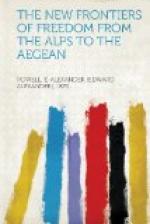Though the Italian element of the population vociferously asserts its adherence to the slogan “Italia o Morte!” I am convinced that many of the more substantial and far-seeing citizens, if they dared freely to express their opinions, would be found to favor the restoration of the city’s ancient autonomy under the aegis of the League of Nations. The Italians of Flume are at bottom, beneath their excitable and mercurial temperaments, a shrewd business people who have the commercial future of their city at heart. And they are intelligent enough to realize that, unless there be established some stable form of government which will propitiate the Slav minority as well as the Italian majority, the Slav nations of the hinterland will almost certainly divert their trade, on which Fiume’s commercial importance entirely depends, to some non-Italian port, in which event the city would inevitably retrograde to the obscure fishing village which it was less than half a century ago.
In order that you may have before you a clear and comprehensive picture of this most perplexing and dangerous situation, which is so fraught with peril for the future peace of the world, suppose that I sketch for you, in the fewest word-strokes possible, the arguments of the rival claimants for fair Fiume’s hand. Italy’s claims may be classified under three heads: sentimental, commercial, and political. Her sentimental claims are based on the ground that the city’s population, character, and history are overwhelmingly Italian. I have already stated that the Italians constitute about three-fourths of the total population of Fiume, the latest figures, as quoted in the United States Senate, giving 29,569 inhabitants to the Italians and 14,798 to the Slavs. There is no denying that the city has a distinctively Italian atmosphere, for its architecture is Italian, that Venetian trademark, the Lion of St. Mark, being in evidence on several of the older buildings; the mode of outdoor life is such as one meets in Italy; most of its stores and banks are owned by Italians, and Italian is the prevailing tongue. The claim that the city’s history is Italian is, however, hardly borne out by history itself, for in the sixteen centuries which have elapsed since the fall of the Roman Empire, Fiume has been under Italian rule—that of the republic of Venice—for just four days.
The commercial reason underlying Italy’s insistence on obtaining control of Fiume is due to the fact that Italians are convinced that should Fiume pass into either neutral or Jugoslav hands, it would mean the commercial ruin of Trieste, where enormous sums of Italian money have been invested. They assert, and with sound reasoning, that the Slavs of the hinterland, and probably the Germans and Magyars as well, would ship through Fiume, were it under Slav or international control, instead of through Trieste, which is Italian. One does not need to be an economist to realize that if Fiume could secure the trade of Jugoslavia and the




